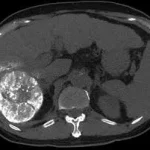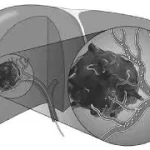Trans arterial chemoembolization (TACE) has emerged as a treatment option for chemotherapy-refractory diseases.
The procedure was initiated with local disinfection and anesthesia, followed by a percutaneous right femoral artery puncture, performed using a modified Seldinger technique. A 5-F Simmons Ⅰ catheter (Impress, Merit Medical Systems, Utah, USA) was introduced through a vascular sheath and positioned in the common hepatic artery with the guidance of digital subtraction angiography to identify the tumor-supplying vessels. A 2.8-F microcatheter catheter (Merit Maestro, Merit Medical Systems, Utah, USA) was advanced into the vessel supplying the hepatic tumor. In cases of bilobar disease, the initial treatment focus was on the lobe with the greatest tumor burden, with the contralateral lobe addressed in a subsequent TACE session scheduled 4–6 weeks apart. An emulsion of chemotherapeutic agents was injected (including Carboplatin 50 mg, Mitomycin 10 mg, and Idarubicin 10 mg) together with iodized oil (2 – 10 mL, Lipiodol Ultra-Fluid; Laboratoire Andre Guerbet, Aulnaysous-Bois, France) and gelatin sponge particles (Gelita-Spon; Gelita Medical GmbH, Eberbach, Germany) as a particle embolization agent. Nab-paclitaxel 100 mg was injected through the TACE procedure in addition to standard drugs-lipiodol emulsion in the nab-paclitaxel group. The procedure was monitored under fluoroscopy until arterial flow stasis was achieved. Devascularization was confirmed by a subsequent hepatic artery angiography. Prior to the treatment, patients in both groups received peripheral intravenous injections of dexamethasone 8 mg, ceftriaxone 1 g, and granisetron 3 mg.
Here we can Write …..
we can write …….


